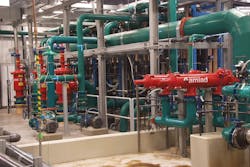The compact footprint of many membrane systems is a big advantage for a growing number of water treatment installations. Many municipalities are struggling to increase water treatment capacity to keep up with rising populations, but often they cannot expand the size of their existing facilities.
Decentralization in the water treatment industry—the creation of neighborhood water treatment plants—is likely to drive more interest in compact water treatment systems. And many industrial facilities find themselves facing new regulations or increasing pressure to recycle water, requiring them to shoehorn sophisticated water treatment systems in crowded settings.
Of course, membranes cannot go it alone. Pretreatment technologies can protect membranes from fouling and dramatically improve the recovery and efficiency of microfiltration (MF), ultrafiltration (UF) or reverse osmosis (RO) filtration. Those pretreatment systems should be compact like the membranes they protect. It would be a shame to squander the footprintshrinking advantage of membranes on a bulky pretreatment technology.
Multi-Stage Approach
Removing sediment from source water before it enters a membrane vessel can significantly increase the interval between membrane cleanings and help minimize plugging, biological fouling and the tearing of the membrane by mollusk shells.
Several technologies are in widespread use for pre-membrane filtration. Larger-pore-size membranes (e.g., MF and UF systems) can protect RO units, but they still require protection of their own from sediment and biofouling. Sand media filters—for centuries the most popular option—are effective but tend to be large and require interruptive, water-intensive backflush. Clarifiers and settling tanks are too large and too slow for many systems.
Cartridge filters work well for prefiltration down to the 1-micron level or even less, but replacing cartridges adds to material, labor and disposal costs. Automatic microfiber (AMF) technology employs cassettes with fine polyester thread to capture small particles, much as cartridge filters do. But it also features self-cleaning action that eliminates the need for handling disposable cartridges.
Automatic self-cleaning screen filters combine uninterrupted filtration with nearly maintenance-free operation, removing filter cake when a target pressure differential is reached. Automatic self-cleaning disk filters also work on a pressure differential trigger, and their depth filtration design is particularly useful when deformable organic solids (e.g., algae) are a principal concern.
Friends in Tight Spaces
Automatic self-cleaning filters are well proven in tight spaces. Amiad filters, for instance, are used aboard several U.S. Navy ships and oil exploration vessels—where space is at an absolute premium—for pre-filtration before membranes. The U.S. Navy also uses the company’s automatic self-cleaning screen filters on skid-mounted, portable water filtration systems for drinking water production in emergencies and remote areas.
Multistage filtration systems are almost infinitely scaleable. Every gallon of the Singapore’s NEWater 200-million-gal-per-day wastewater recycling system passes through an automatic self-cleaning screen filter on its way to membrane treatment and disinfection.
On a municipal level, compact screen filters have helped a Southwestern city double its water treatment capacity without expanding its brick building, and they allowed a Canadian town to pretreat lake water in a facility that had to be wedged into a narrow valley. A Northwestern city replaced a sand media system with an MF membrane system preceded by a 300-micron automatic self-cleaning screen, doubling its drinking water production while reducing the size of its system’s footprint. This left the city room to keep up with future population growth.
Environmentally Aware
In addition to delivering efficient filtration in a compact physical footprint, automatic self-cleaning screen and disk filters operate with a small environmental footprint. These technologies typically use less than 1% of the flow for backflushing. By contrast, traditional sand media systems can consume as much as 5% of flow for backflushing.
In addition to creating challenges for disposal, backflush water can represent a significant financial loss in some systems. Water that has received a dose of disinfectant or that has been heated or cooled is costly water. There already has been an investment in the water, and flushing it from the system wastes more than just its raw water value.
The most efficient way to prevent that loss is to adopt technology that minimizes backflushing. For systems already built around sand media prefiltration, Amiad has engineered a backflush filtration system that allows water treatment facilities to recycle a majority of their backflush water and reintroduce it to the front of their systems.
Water from the first few minutes of backflushing, which typically contains the bulk of the total suspended solids, is directed to a settling tank and managed largely through dewatering and sludge removal. Water from the remainder of the backflush cycle, which represents the majority of the sand media system’s reject water, can be filtered through an automatic screen filter and an AMF filter before reintroduction to the treatment plant’s feed. As a result, production is increased and waste is minimized.
Other factors surrounding a system’s environmental footprint include energy, chemical and even the concrete and steel needed to construct the infrastructure. Minimizing those variables with highly efficient, compact pretreatment technology further improves the ecological profile of the entire treatment system.
In all, specifying a prefiltration approach that has a small physical and environmental footprint helps membrane technology fully deliver its benefits—from its own compact footprint to its outstanding performance.
Download: Here


